?
Early St. Louis Hospitals, Homes, and Asylums
Early St. Louis Hospitals, Homes, and Asylums
To return to the "Genealogy in St. Louis" Web Site click here.
David A. Lossos - updated 9/24/2011
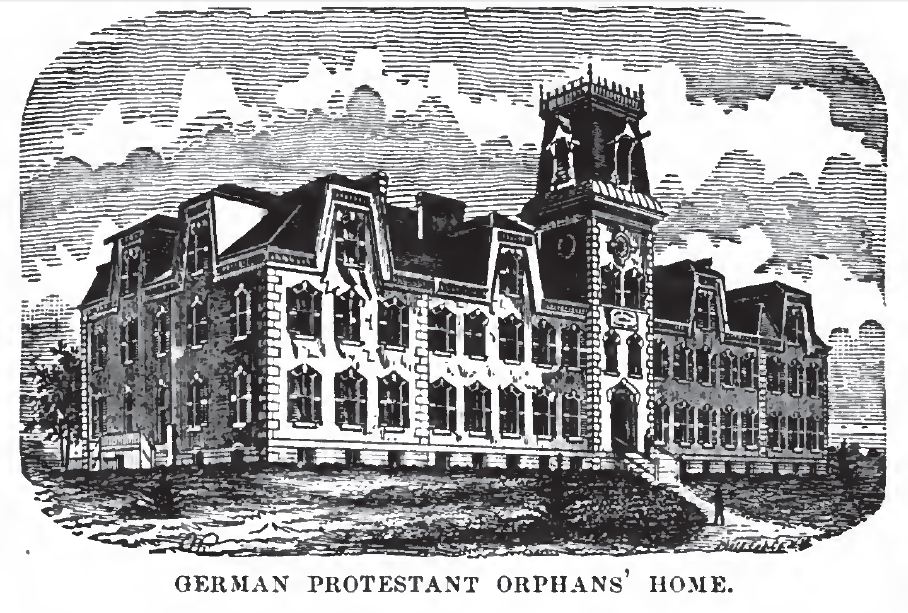
The following history is quoted from the ECH website at http://everychildshope.org/page.aspx?pid=265
"In 1858, Reverend Louis Nollau began what was to become an enduring mission. He opened the basement of his church, St. Peter's Evangelical Church as shelter to a young boy named Henry Sam, and so the German Protestant Orphans Home began. Many other children followed, due to the recurrent outbreaks of cholera, a fatal disease at the time. This all important orphanage later became ECH and has stood the test of time for over 150 years.
Incorporated in 1861, the then German Protestant Orphan's Home operated in the parsonage at St. Peter's Evangelical Church for the next two years. As more children arrived, these quarters became too small, so the orphanage moved to a larger home on Carr Street in downtown St. Louis.
Following a fire in 1863, Rev. Nollau and the Board of Directors felt that the children needed a place in the country where they could breathe the clean air and learn a trade. They purchased a 65-acre farm on the St. Charles Rock Road for $23,500. The farm was on one of the highest points of St. Louis County and provided a substantial mansion, outbuildings, faming fields, as well as over 1,000 fruit bearing trees.
In the fall of 1866, 60 boys and girls moved to the "country." It was a half-day's ride from the city by farm wagon.
By 1874, the number of children reached 250 and the Board of Directors had to make the decision to turn some children away. The "family" had outgrown its current home. So, to accommodate everyone, that fall, the original mansion was rebuilt to house all the children, staff and a school on the grounds.
Three years later, in 1877, during a blizzard, this newly re-modeled building caught fire. The children were temporarily moved to other orphanages in the area. Just eleven months after the blaze, a new home was built on the existing foundation and dedicated in November 1877.
The German Protestant Orphan's Home continued to thrive. Every transaction, every communication was done in German. In 1917, after World War I, the Board decided that all religious instruction, education, communication and all publications should be done in English. Then in September 1918, all other transactions were changed to English."
In "Pictorial St. Louis ... 1875" is written:
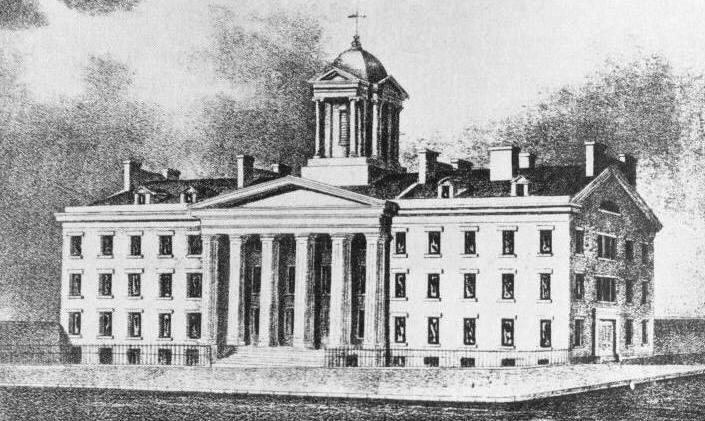 "In the matter of public and private charities, St.
Louis of the present day challenges the admiration of
the civilized world. No other city in America. of the
same amount of population, can boast of the same
number of eleemosynary institutions, where the
unfortunate of mankind receive food. medical
attendance, and shelter, as our own. The buildings
are all of a superior order of architecture, and
admirably adapted for hospital purposes. The rapidity
with which our city has been populated. the great
influx of foreigners who come here, many suffering
from disease and neglect, all unaccustomed to the
changes of our climate. of food and water, produces
great suffering, which, in many cases, results in
death. Large numbers of children are thus left
without their natural protectors, others are destitute
the means of procuring food or medical attendance,
while others have no place of shelter in which they
can avail themselves of suitable attendance and
nursing, even if possessed of the means to command
such. These, and other causes, cast each year thousands of our unfortunate fellow creatures upon our hands, for whose
support and maintenance the sympathies of the charitable public are solicited.
"In the matter of public and private charities, St.
Louis of the present day challenges the admiration of
the civilized world. No other city in America. of the
same amount of population, can boast of the same
number of eleemosynary institutions, where the
unfortunate of mankind receive food. medical
attendance, and shelter, as our own. The buildings
are all of a superior order of architecture, and
admirably adapted for hospital purposes. The rapidity
with which our city has been populated. the great
influx of foreigners who come here, many suffering
from disease and neglect, all unaccustomed to the
changes of our climate. of food and water, produces
great suffering, which, in many cases, results in
death. Large numbers of children are thus left
without their natural protectors, others are destitute
the means of procuring food or medical attendance,
while others have no place of shelter in which they
can avail themselves of suitable attendance and
nursing, even if possessed of the means to command
such. These, and other causes, cast each year thousands of our unfortunate fellow creatures upon our hands, for whose
support and maintenance the sympathies of the charitable public are solicited.
In the matter of hospitals, we have eleven as noble institutions as ever graced any modern city - institutions whose
hospitable walls multitudes are rescued from misery, and perhaps death, by the kind attentions of those to whom they were
litter strangers, and on whom they had no claim but a common humanity. These buildings are all large, well ventilated,
remarkable for strict cleanliness, and to supplied with every facility for restoring the sick to perfect health. Some of these
buildings are also highly ornamented, doing great credit to their founders and managers, and also to the city, by whom they
are sustained. Some of them are self-sustaining, others are sustained entirely by charity. Both, however, deserve the greatest
credit for the space they fill in our midst. We do not wish to make any invidious comparisons, but simple justice, which the
public of St. Louis will not fail to appreciate, compels us to state that the greater number of these establishments have been
established by the friends of the Roman Catholic Church, whose members have, in all ages, been noted munificent charities.
THE CITY HOSPITAL
 "The oldest, as well as the most important
of our public charities, is the City
Hospital. This institution dates back over
thirty years, and was built, is owned, and
sustained by the city. In every respect it is,
and always has been, a noble charity, a
home for the suffering of all nations,
where the sick and destitute stranger, be
his nationality or religious creed what
they may, finds a shelter from the storms
of life, and kind and gentle hands to
soothe his sick pillow. It is curious to
notice in the returns of this establishment,
made each year by the officer in charge,
the various countries from which the
patients come who are admitted here. Not
only is every State in the American Union
represented, but every country of Europe,
South America, and even occasionally
some portions of Asia. This goes to show what a point of concentration St. Louis is. It is a noble charity, to which the city
can point with pride, as evincing the philanthropy of our people. Few public hospitals in the United States can compare with
this. It is admirably arranged, in a high. airy, eligible position, and its cleanliness is the marvel and wonder of all who visit it.
No pains are spared to make it attractive and agreeable, and much credit is due to the admirable management of the officers
in charge. who sustain an exalted reputation for care and attention. The grounds. large and spacious, are neatly laid out, and
present the appearance of a summer garden. The city, through the mayor and council, takes great pride in this important and
valuable establishment, and the board of health especially watch over its arrangements, while the regular physician and his
assistants, paid by the city, endeavor to make it all that the city wants -- the very best of hospitals. The entire structure is
built of the very best brick, and is finished in the most substantial manner, with ample supplies of water, bathing apparatus.
and every convenience for the restoration of health and the promotion of comfort, that modern science and philanthropy
have been enabled to devise. Attached is a drug store and other appurtenances, supplied by the city, and the whole is so
arranged as to accommodate over six hundred patients."
"The oldest, as well as the most important
of our public charities, is the City
Hospital. This institution dates back over
thirty years, and was built, is owned, and
sustained by the city. In every respect it is,
and always has been, a noble charity, a
home for the suffering of all nations,
where the sick and destitute stranger, be
his nationality or religious creed what
they may, finds a shelter from the storms
of life, and kind and gentle hands to
soothe his sick pillow. It is curious to
notice in the returns of this establishment,
made each year by the officer in charge,
the various countries from which the
patients come who are admitted here. Not
only is every State in the American Union
represented, but every country of Europe,
South America, and even occasionally
some portions of Asia. This goes to show what a point of concentration St. Louis is. It is a noble charity, to which the city
can point with pride, as evincing the philanthropy of our people. Few public hospitals in the United States can compare with
this. It is admirably arranged, in a high. airy, eligible position, and its cleanliness is the marvel and wonder of all who visit it.
No pains are spared to make it attractive and agreeable, and much credit is due to the admirable management of the officers
in charge. who sustain an exalted reputation for care and attention. The grounds. large and spacious, are neatly laid out, and
present the appearance of a summer garden. The city, through the mayor and council, takes great pride in this important and
valuable establishment, and the board of health especially watch over its arrangements, while the regular physician and his
assistants, paid by the city, endeavor to make it all that the city wants -- the very best of hospitals. The entire structure is
built of the very best brick, and is finished in the most substantial manner, with ample supplies of water, bathing apparatus.
and every convenience for the restoration of health and the promotion of comfort, that modern science and philanthropy
have been enabled to devise. Attached is a drug store and other appurtenances, supplied by the city, and the whole is so
arranged as to accommodate over six hundred patients."
"The resident physician is Dr. G. Hurt, a man no less
renowned for his professional skill than for his
philanthropic feelings for the afflicted of his race.
Under his immediate supervision the City Hospital is
everything it should be -- an honor to St. Louis, and
a home, in every acceptation of the word, to the
outcast and friendless stranger."
From This is our Saint Louis (written in 1970):
"The St. Louis City Hospital had its origin in an
ordinance passed by the City Council on July 10, 1845, authorizing the appointment of a committee of five to choose a site
and have plans drawn for a city hospital building. A tract of land, comprising about eight acres, was selected at the head of
Soulard Street, where is now the intersection of Fourteenth (formerly Linn) Street and Lafayette Avenue. Contracts were let
and the structure partly finished for the reception of patients in June, 1846. Only ninety patients could then be
accommodated, but a number of additions were built during the next ten years. The entire hospital was completely destroyed
by fire on May 15, 1856, with the loss of but one life, that of an insane Italian who had been rescued only to run back into
the burning building.
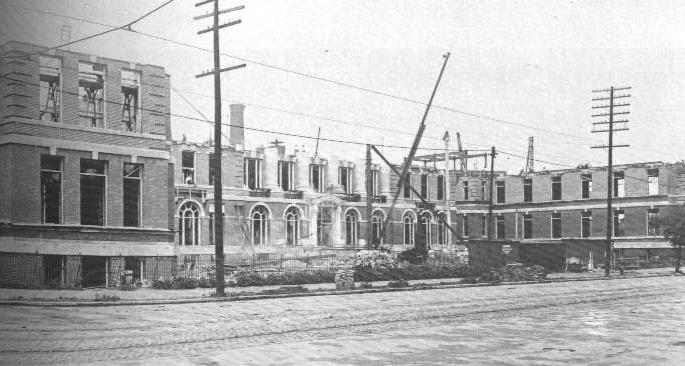 Awaiting the erection of a new building the City
authorities made arrangements for the patients at the
new United States Marine Hospital and at the County
Farm until by May 1857 a new hospital occupying
the old site was completed at a cost of $62,000.
Large additions were made in later years so that
eventually about 450 patients were cared for there.
That was the number of inmates when the severe
tornado of May 27, 1896, swept diagonally through
the southern section of the city and wholly wrecked
the buildings of the hospital with, however, only
three deaths among the patients.
Awaiting the erection of a new building the City
authorities made arrangements for the patients at the
new United States Marine Hospital and at the County
Farm until by May 1857 a new hospital occupying
the old site was completed at a cost of $62,000.
Large additions were made in later years so that
eventually about 450 patients were cared for there.
That was the number of inmates when the severe
tornado of May 27, 1896, swept diagonally through
the southern section of the city and wholly wrecked
the buildings of the hospital with, however, only
three deaths among the patients.
It was quite fortunate that at the time the Convent of
the Good Shepherd, between 17th and 18th and Chestnut and Pine Street was yet unoccupied. Accordingly, patients,
doctors, nurses and other personnel were removed to that place and there part of the institution was right comfortably
housed for about eleven years as Emergency Hospital No. 1, while another group was established in the old Pius Hospital on
14th and O'Fallon Street and called Emergency Hospital No. 2. Communicable diseases were housed in the latter structure.
The new City Hospital occupying again the site of the wrecked institution on Lafayette Ave. between 14th, Grattan and
Carroll Streets, (actually four city blocks) was finished in 1907, and occupied in October of that year. Infectious diseases
were also cared for there for three or four years, after which they were moved to the old Female Hospital across the street
from the City Infirmary on Arsenal Street, on the highest ground within the city limits."
THE CITY DISPENSARY
The City Dispensary is situated in the City Hall Building, corner of Eleventh and Chestnut Streets, and is one of our most
important public charities. It is under the direction of Drs. Love and Robinson, one of whom is in constant attendance night
and day. During the year 1874, 33.460 patients were examined and treated at this dispensary. Patients are not only sent to
the different hospitals by the doctors in charge, hut the poor and indigent of the city prescribed for, and medicine furnished
to them.
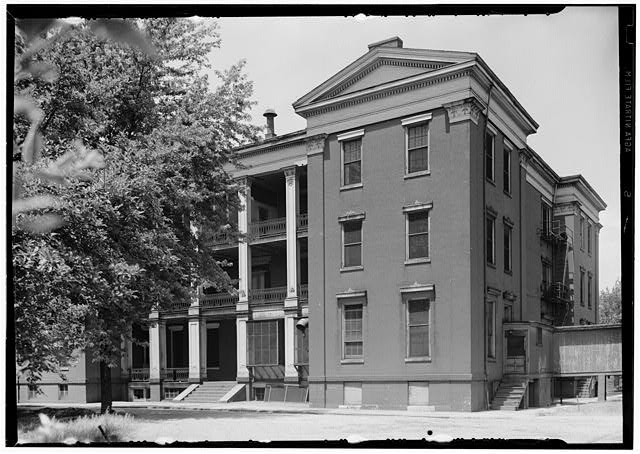
THE MARINE HOSPITAL
This hospital is in the southern portion of the city, below the Arsenal
grounds, occupying an elevated and healthy position overlooking the
river. It is a beautiful brick structure, built by the United States in 1854,
and devoted to the care and attendance of sea-faring men. It fills an
important want in St. Louis, and is one of the best conducted institutions
iii the country. It is a national establishment, and is under the charge of Dr. G. T. Allen.
THE FEMALE HOSPITAL (aka, Social Evil Hospital)
In "Pictorial St. Louis ... 1875" is written:
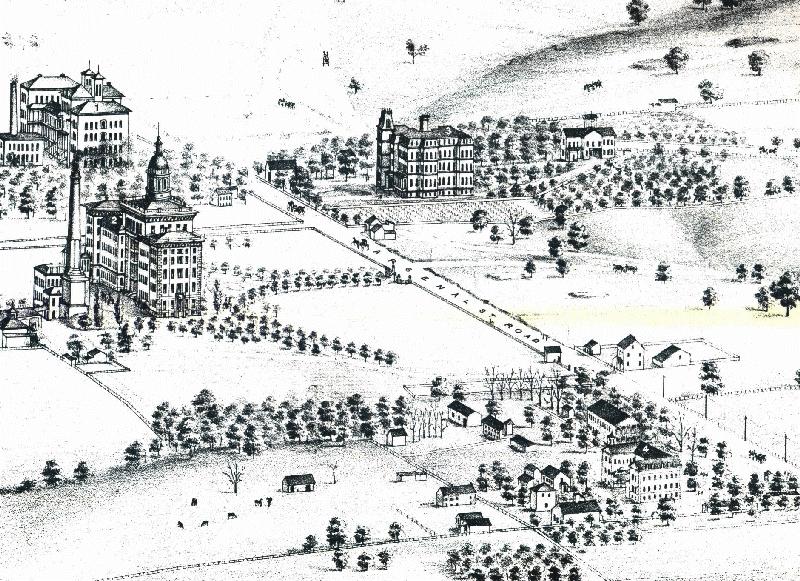 "This institution was
for many years known
as the Social Evil
Hospital, and was
erected in 1873, under
the mayoralty of Hon.
Joseph Brown, from a
fund gathered under
the provisions of the,
now repealed, Social
Evil Law. It is a
handsome brick
structure, costing
over $100,000, and
situated outside the
city limits, at the
intersection of the
Manchester and
Arsenal Roads. It was
first used exclusively
for the care and
treatment of social
outcasts, who, under
the social evil law,
were taxed for its
support. Since the
repeal of this law, which proved obnoxious to many of our citizens, it has been used as a female hospital exclusively, for the
treatment of all the indigent and poor female sick of the city, from whatever disease or accident they may suffer. Dr. P. V.
Schenck is the resident physician.
"This institution was
for many years known
as the Social Evil
Hospital, and was
erected in 1873, under
the mayoralty of Hon.
Joseph Brown, from a
fund gathered under
the provisions of the,
now repealed, Social
Evil Law. It is a
handsome brick
structure, costing
over $100,000, and
situated outside the
city limits, at the
intersection of the
Manchester and
Arsenal Roads. It was
first used exclusively
for the care and
treatment of social
outcasts, who, under
the social evil law,
were taxed for its
support. Since the
repeal of this law, which proved obnoxious to many of our citizens, it has been used as a female hospital exclusively, for the
treatment of all the indigent and poor female sick of the city, from whatever disease or accident they may suffer. Dr. P. V.
Schenck is the resident physician.
THE COUNTY INSANE ASYLUM
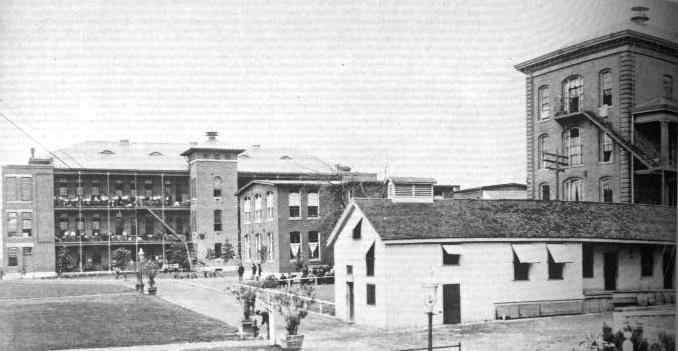 "This magnificent establishment is situated on Arsenal
Avenue, near the Manchester Road, and is one of the
finest asylums in the United States. This is emphatically
a public charity, and is supported by the public. This
institution contains from 400 to 500 patients, from the
county and city. It is conducted by the county court,
who regulate all its different departments. It is fitted
up with every facility for the cure or amelioration of the
condition or the afflicted of God's creatures, who find
an asylum within its walls. Dr. D. V. N. Howard is the
physician in charge."
"This magnificent establishment is situated on Arsenal
Avenue, near the Manchester Road, and is one of the
finest asylums in the United States. This is emphatically
a public charity, and is supported by the public. This
institution contains from 400 to 500 patients, from the
county and city. It is conducted by the county court,
who regulate all its different departments. It is fitted
up with every facility for the cure or amelioration of the
condition or the afflicted of God's creatures, who find
an asylum within its walls. Dr. D. V. N. Howard is the
physician in charge."
The following images were received from Debbie Gorry.
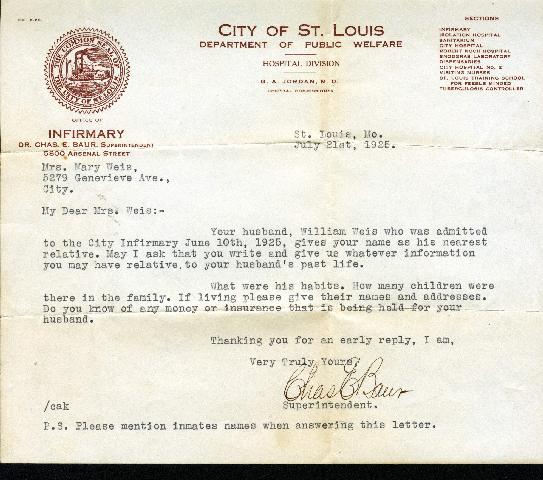
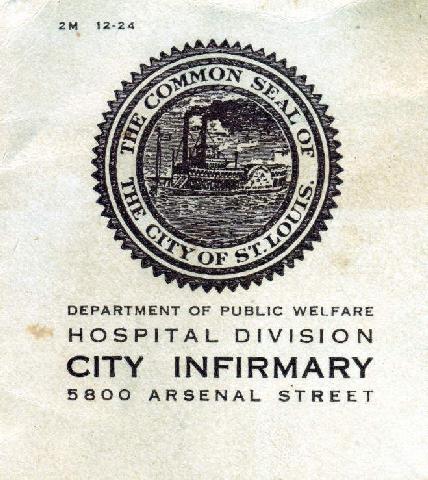
From This is our Saint Louis (written in 1970):
The beginning of this institution dates back to 1846 when that part of the Kemper College tract which was located east of
the Blue Ridge Rd. (now Sublette Ave.) and which measured 42.12 acres was set aside for this future purpose. The
institution was opened on April 23rd, 1869, and, being owned and operated by the County of St. Louis, it was known as the
"St. Louis County Insane Asylum." It is reported that on the opening day 129 patients were admitted. After the City of St.
Louis separated from the County of St. Louis on October 22nd, 1876, this hospital was re-named the "St. Louis Insane
Asylum." This institution was tremendously enlarged in 1912 when the so-called "Million Dollar Annex" was completed.
Many improvements were also made in the late twenties when a bond issue provided the necessary funds. The original center
building was fire-proofed throughout, a large auditorium for the purpose of enabling various types of entertainment for the
patients was provided along with a cafeteria for the employees and an up-to-date employees building. In keeping with the
physical improvements of this institution a concerted effort was started in 1930 to im- prove the medical and nursing care of
the patients. To this end the resident staff was considerably enlarged, graduate nurses were provided and whatever was
needed in diagnostic and therapeutic equipment was supplied. While formerly the City Sanitarium was essentially a custodial
institution, it has gradually become a first class hospital for the diagnosis and treatment of mental disorders. At the present
time it houses approximately 3500 patients. In studying the history of the present City Sanitarium and the City Infirmary it is
interesting to note that these institutions were originally county institutions. This status prevailed until October 22nd, 1876,
when the City of St. Louis separated from the County of St. Louis under an agreement which is officially referred to as the
"Scheme of Separation." This agreement contains a clause which gives the County of St. Louis the right to send patients to
these former county institutions until such a time when the county will again have institutions of its own and with the
understanding that the county will pay for the maintenance of its patients at the city institution at the prevailing per capita per
diem cost. As a result of this provision St. Louis County is still making use in a limited way of the Infirmary, the Sanitarium,
the Isolation, the Homer G. Phillips Hospital and the City Hospital.
THE ST. LOUIS HOSPITAL
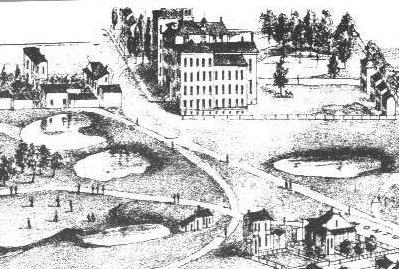 This is more favorably known as the
"Sister's Hospital," being under the
direction of the Sisters of Charity. It is
situated on Montgomery Street, near the
corner of Bacon. This institution which, for
over a quarter of a century, was on the
corner of Fourth and Spruce Streets, was
the first establishment of the kind west of
the Mississippi. The ground was donated
by the philanthropic Hon. Bryan
Mullanphy, who, at an early date,
perceived the want of such an
establishment. The present buildings were,
erected by the sisters in 1873-74, and are
equal to any similar establishment in the
United States. It is not, however, a public
charity, in the general acceptation of the
term. The public can use it, but it is
self-sustaining. Very many go there and
pay for attendance, preferring it either to a
public or private hospital, and this is
especially the case with strangers or parties who have no home, and desire good nursing and attendance, and are able to pay
for it. Here they can obtain their room, their own physician, if they so desire, or, if they have no preference, the services of
those medical men who attend the institution, which are the best the city affords. It is conducted entirely by the Sisters of
Charity.
This is more favorably known as the
"Sister's Hospital," being under the
direction of the Sisters of Charity. It is
situated on Montgomery Street, near the
corner of Bacon. This institution which, for
over a quarter of a century, was on the
corner of Fourth and Spruce Streets, was
the first establishment of the kind west of
the Mississippi. The ground was donated
by the philanthropic Hon. Bryan
Mullanphy, who, at an early date,
perceived the want of such an
establishment. The present buildings were,
erected by the sisters in 1873-74, and are
equal to any similar establishment in the
United States. It is not, however, a public
charity, in the general acceptation of the
term. The public can use it, but it is
self-sustaining. Very many go there and
pay for attendance, preferring it either to a
public or private hospital, and this is
especially the case with strangers or parties who have no home, and desire good nursing and attendance, and are able to pay
for it. Here they can obtain their room, their own physician, if they so desire, or, if they have no preference, the services of
those medical men who attend the institution, which are the best the city affords. It is conducted entirely by the Sisters of
Charity.
Mullanphy Emigrant Home
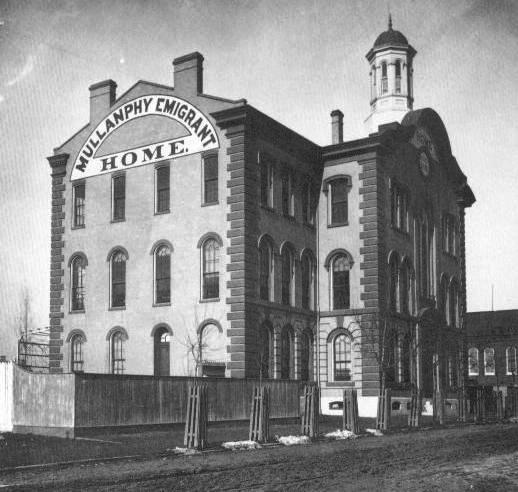 This is among the most munificent charities ever established in
America. It is the gift of the late Bryan Mullanphy, who donated
a large sum of money for the purpose of establishing a home and
protection for emigrants of all nationalities and all religious
denominations. The fund has always been in the hands of a
board of managers, appointed by the city council to conduct the
affairs of this donation. This fund has been so carefully and
economically managed that it has increased to enormous
proportions. The Home is a magnificent brick structure, on the
west side of Fourteenth Street, between Mullanphy and Howard
Streets. Here emigrants arriving in the city and out of funds, are
supplied with a home until they can obtain work, or they are
forwarded to the other States, whither they are journeying. The
office of the board is at 307 Locust Street.
This is among the most munificent charities ever established in
America. It is the gift of the late Bryan Mullanphy, who donated
a large sum of money for the purpose of establishing a home and
protection for emigrants of all nationalities and all religious
denominations. The fund has always been in the hands of a
board of managers, appointed by the city council to conduct the
affairs of this donation. This fund has been so carefully and
economically managed that it has increased to enormous
proportions. The Home is a magnificent brick structure, on the
west side of Fourteenth Street, between Mullanphy and Howard
Streets. Here emigrants arriving in the city and out of funds, are
supplied with a home until they can obtain work, or they are
forwarded to the other States, whither they are journeying. The
office of the board is at 307 Locust Street.
After 1825 many other philanthropies developed. In 1826 the city
of St. Louis petitioned the legislature for funds to build a
poorhouse, primarily for destitute immigrants. In 1818 the Erin
Benevolent Society was formed, and in 1827 an Irish group
established the Missouri Hibernian Relief Society to relieve
distress in their homeland. Efforts to establish a hospital failed
until 1828 when some Sisters of Charity arrived and began a hospital on Spruce Street near Third, in a log house with two
rooms and a kitchen. With the strong support of Mayor Lane, St. Louis raised funds for an adequate new hospital,
completed in 1832, also on Spruce Street. In 1834, under the vigilant leadership of Ann Perry, The St. Louis Association of
Ladies for the Relief of Orphan Children (later incorporated as the St. Louis Protestant Orphans' Asylum) was established.
Although most important -- as well as many lesser-known -- St. Louisans supported charity, few Creoles assumed
leadership roles, nor did they provide the chief financial support. Almost without exception, the Anglo-Americans and Irish
in St. Louis conceived, directed, and largely financed charitable projects. The most notable gifts were made by the
Mullanphys: the eccentric father, John, and his two no-less-eccentric children, Bryan and Ann Mullanphy Biddle. With funds
inherited from her husband and with her share of her father's estate, Ann would make charitable donations that expressed a
deep concern for the poor and unfortunate. They may also have helped fill the emptiness of her life without children or many
close friends. During her lifetime she gave land to the Visitation Convent; she was generous with the Girl's Orphan Asylum;
and she founded the Biddle Foundling Asylum and Lying-In Hospital. In her will she left funds for many charities, including
the construction of a Widows' Home.
QUARANTINE HOSPITAL
Situated in the southern portion of the city, is also among the noted public charities. It is of the same character as the City
Hospital, supported by, and under the direction of, the city, through the board of health. This hospital contains a separate
"lying-in ward," and a department for the exclusive treatment of small-pox patients. The grounds attached to the
establishment are under good cultivation, and much improved. Dr. R. S. Anderson is the resident physician.
In addition to the hospitals already mentioned, are the
- General Evangelical Lutheran Hospital and Asylum, on the corner of Seventh and Sidney Streets, a very important
institution, of which Rev. J. F. Buenger is president, and Theodore Schultz superintendent.
- The Good Samaritan Hospital, on Jefferson Avenue, at the head of O'Fallon Street, and of which Adolphus Meier,
Esq., is president, and Henry Wiebusch secretary.
- Biddle Infant Asylum and Lying-in Hospital is located on O'Fallon Street, corner of Tenth, and is conducted by the
Sisters of Charity.
- St. Boniface Hospital, on the Lami Ferry Road, south of River des Peres, Carondelet, and Father Shindel is director.
- St. John's Hospital, corner of Twenty-Third and Morgan Streets.
- The Alexian Brother Hospital one of the finest institutions of the sort in the country, situated in the southern portion of
the city, on the northwest corner of Jefferson and Osage Avenues. Aloysius Schyns is superior, and Dr. F. W. Wesseler
attending physician.
- The St. Louis Lying-In Charity, central office, 201 South Fifth Street, Dr. George J. Englemann, physician in chief.
- St. Luke's Hospital, Episcopalian, under the charge of the sisterhood of the Good Shepherd, 913 Pine Street.
- St. Vincent's Asylum, one of the most renowned in the West, is situated on the corner of Marion and Decatur Streets.
This establishment is under the charge of the sisters, who devote their whole time and attention to the care of the afflicted
who come under their charge. This is not a public charity, but is made self-sustaining. They have always a large number
of patients, from the city and from abroad, whose friends pay for their treatment. It is one of the most popular asylums in
the western country, and has patients from almost every State in the Union.
- Episcopal Orphan's Home, under the direction of the Sisters of the Good Shepherd, is situated on the corner of
Lafayette and Grand Avenues. Mrs. G. Douglass is secretary.
- Little Sisters of the Poor, home for indigent and aged people, on the northwest corner of Nineteenth and Hebert Streets.
Anatolie Joseph is mother superior.
- St. Joseph's Male Orphan Asylum is on Clark Avenue, near the corner of Fifteenth Street, and is under the direction of
the Sisters of St. Joseph. Mother Basil is superior.
- St. Mary Female Orphan Asylum is on the corner of Tenth and Biddle Streets, and is conducted by the Sisters of
Charity. Sister Emily is the sister servant.
- St. Vincent's German Orphan Asylum. Sister Angela, mother superior, is on Twentieth Street, between O'Fallon
Street and Cass Avenue.
Sources:
Pictorial St. Louis - the great metropolis of the Mississippi Valley: a topographical survey drawn in perspective, A. D.
1875. - Dry, Camille N. St. Louis: McGraw-Young Publishing, 1997
This is our Saint Louis - published by Knight Publishing Company, 1970. Harry M. Hagen.
Saint Louis - An Informal History of the City and its People, 1764-1865. van Ravenswaay, Charles. St. Louis: Missouri
Historical Society Press, 1991. ISBN 0-252-1915-6, 568 pages
For information (and photos) of St. Louis City Hospital click here.
For information (and photos) of St. Mary's Infirmary (built in 1889) at 1536-48 Papin Street click here.

 "In the matter of public and private charities, St.
Louis of the present day challenges the admiration of
the civilized world. No other city in America. of the
same amount of population, can boast of the same
number of eleemosynary institutions, where the
unfortunate of mankind receive food. medical
attendance, and shelter, as our own. The buildings
are all of a superior order of architecture, and
admirably adapted for hospital purposes. The rapidity
with which our city has been populated. the great
influx of foreigners who come here, many suffering
from disease and neglect, all unaccustomed to the
changes of our climate. of food and water, produces
great suffering, which, in many cases, results in
death. Large numbers of children are thus left
without their natural protectors, others are destitute
the means of procuring food or medical attendance,
while others have no place of shelter in which they
can avail themselves of suitable attendance and
nursing, even if possessed of the means to command
such. These, and other causes, cast each year thousands of our unfortunate fellow creatures upon our hands, for whose
support and maintenance the sympathies of the charitable public are solicited.
"In the matter of public and private charities, St.
Louis of the present day challenges the admiration of
the civilized world. No other city in America. of the
same amount of population, can boast of the same
number of eleemosynary institutions, where the
unfortunate of mankind receive food. medical
attendance, and shelter, as our own. The buildings
are all of a superior order of architecture, and
admirably adapted for hospital purposes. The rapidity
with which our city has been populated. the great
influx of foreigners who come here, many suffering
from disease and neglect, all unaccustomed to the
changes of our climate. of food and water, produces
great suffering, which, in many cases, results in
death. Large numbers of children are thus left
without their natural protectors, others are destitute
the means of procuring food or medical attendance,
while others have no place of shelter in which they
can avail themselves of suitable attendance and
nursing, even if possessed of the means to command
such. These, and other causes, cast each year thousands of our unfortunate fellow creatures upon our hands, for whose
support and maintenance the sympathies of the charitable public are solicited. "The oldest, as well as the most important
of our public charities, is the City
Hospital. This institution dates back over
thirty years, and was built, is owned, and
sustained by the city. In every respect it is,
and always has been, a noble charity, a
home for the suffering of all nations,
where the sick and destitute stranger, be
his nationality or religious creed what
they may, finds a shelter from the storms
of life, and kind and gentle hands to
soothe his sick pillow. It is curious to
notice in the returns of this establishment,
made each year by the officer in charge,
the various countries from which the
patients come who are admitted here. Not
only is every State in the American Union
represented, but every country of Europe,
South America, and even occasionally
some portions of Asia. This goes to show what a point of concentration St. Louis is. It is a noble charity, to which the city
can point with pride, as evincing the philanthropy of our people. Few public hospitals in the United States can compare with
this. It is admirably arranged, in a high. airy, eligible position, and its cleanliness is the marvel and wonder of all who visit it.
No pains are spared to make it attractive and agreeable, and much credit is due to the admirable management of the officers
in charge. who sustain an exalted reputation for care and attention. The grounds. large and spacious, are neatly laid out, and
present the appearance of a summer garden. The city, through the mayor and council, takes great pride in this important and
valuable establishment, and the board of health especially watch over its arrangements, while the regular physician and his
assistants, paid by the city, endeavor to make it all that the city wants -- the very best of hospitals. The entire structure is
built of the very best brick, and is finished in the most substantial manner, with ample supplies of water, bathing apparatus.
and every convenience for the restoration of health and the promotion of comfort, that modern science and philanthropy
have been enabled to devise. Attached is a drug store and other appurtenances, supplied by the city, and the whole is so
arranged as to accommodate over six hundred patients."
"The oldest, as well as the most important
of our public charities, is the City
Hospital. This institution dates back over
thirty years, and was built, is owned, and
sustained by the city. In every respect it is,
and always has been, a noble charity, a
home for the suffering of all nations,
where the sick and destitute stranger, be
his nationality or religious creed what
they may, finds a shelter from the storms
of life, and kind and gentle hands to
soothe his sick pillow. It is curious to
notice in the returns of this establishment,
made each year by the officer in charge,
the various countries from which the
patients come who are admitted here. Not
only is every State in the American Union
represented, but every country of Europe,
South America, and even occasionally
some portions of Asia. This goes to show what a point of concentration St. Louis is. It is a noble charity, to which the city
can point with pride, as evincing the philanthropy of our people. Few public hospitals in the United States can compare with
this. It is admirably arranged, in a high. airy, eligible position, and its cleanliness is the marvel and wonder of all who visit it.
No pains are spared to make it attractive and agreeable, and much credit is due to the admirable management of the officers
in charge. who sustain an exalted reputation for care and attention. The grounds. large and spacious, are neatly laid out, and
present the appearance of a summer garden. The city, through the mayor and council, takes great pride in this important and
valuable establishment, and the board of health especially watch over its arrangements, while the regular physician and his
assistants, paid by the city, endeavor to make it all that the city wants -- the very best of hospitals. The entire structure is
built of the very best brick, and is finished in the most substantial manner, with ample supplies of water, bathing apparatus.
and every convenience for the restoration of health and the promotion of comfort, that modern science and philanthropy
have been enabled to devise. Attached is a drug store and other appurtenances, supplied by the city, and the whole is so
arranged as to accommodate over six hundred patients." Awaiting the erection of a new building the City
authorities made arrangements for the patients at the
new United States Marine Hospital and at the County
Farm until by May 1857 a new hospital occupying
the old site was completed at a cost of $62,000.
Large additions were made in later years so that
eventually about 450 patients were cared for there.
That was the number of inmates when the severe
tornado of May 27, 1896, swept diagonally through
the southern section of the city and wholly wrecked
the buildings of the hospital with, however, only
three deaths among the patients.
Awaiting the erection of a new building the City
authorities made arrangements for the patients at the
new United States Marine Hospital and at the County
Farm until by May 1857 a new hospital occupying
the old site was completed at a cost of $62,000.
Large additions were made in later years so that
eventually about 450 patients were cared for there.
That was the number of inmates when the severe
tornado of May 27, 1896, swept diagonally through
the southern section of the city and wholly wrecked
the buildings of the hospital with, however, only
three deaths among the patients. 
 "This institution was
for many years known
as the Social Evil
Hospital, and was
erected in 1873, under
the mayoralty of Hon.
Joseph Brown, from a
fund gathered under
the provisions of the,
now repealed, Social
Evil Law. It is a
handsome brick
structure, costing
over $100,000, and
situated outside the
city limits, at the
intersection of the
Manchester and
Arsenal Roads. It was
first used exclusively
for the care and
treatment of social
outcasts, who, under
the social evil law,
were taxed for its
support. Since the
repeal of this law, which proved obnoxious to many of our citizens, it has been used as a female hospital exclusively, for the
treatment of all the indigent and poor female sick of the city, from whatever disease or accident they may suffer. Dr. P. V.
Schenck is the resident physician.
"This institution was
for many years known
as the Social Evil
Hospital, and was
erected in 1873, under
the mayoralty of Hon.
Joseph Brown, from a
fund gathered under
the provisions of the,
now repealed, Social
Evil Law. It is a
handsome brick
structure, costing
over $100,000, and
situated outside the
city limits, at the
intersection of the
Manchester and
Arsenal Roads. It was
first used exclusively
for the care and
treatment of social
outcasts, who, under
the social evil law,
were taxed for its
support. Since the
repeal of this law, which proved obnoxious to many of our citizens, it has been used as a female hospital exclusively, for the
treatment of all the indigent and poor female sick of the city, from whatever disease or accident they may suffer. Dr. P. V.
Schenck is the resident physician.  "This magnificent establishment is situated on Arsenal
Avenue, near the Manchester Road, and is one of the
finest asylums in the United States. This is emphatically
a public charity, and is supported by the public. This
institution contains from 400 to 500 patients, from the
county and city. It is conducted by the county court,
who regulate all its different departments. It is fitted
up with every facility for the cure or amelioration of the
condition or the afflicted of God's creatures, who find
an asylum within its walls. Dr. D. V. N. Howard is the
physician in charge."
"This magnificent establishment is situated on Arsenal
Avenue, near the Manchester Road, and is one of the
finest asylums in the United States. This is emphatically
a public charity, and is supported by the public. This
institution contains from 400 to 500 patients, from the
county and city. It is conducted by the county court,
who regulate all its different departments. It is fitted
up with every facility for the cure or amelioration of the
condition or the afflicted of God's creatures, who find
an asylum within its walls. Dr. D. V. N. Howard is the
physician in charge."

 This is more favorably known as the
"Sister's Hospital," being under the
direction of the Sisters of Charity. It is
situated on Montgomery Street, near the
corner of Bacon. This institution which, for
over a quarter of a century, was on the
corner of Fourth and Spruce Streets, was
the first establishment of the kind west of
the Mississippi. The ground was donated
by the philanthropic Hon. Bryan
Mullanphy, who, at an early date,
perceived the want of such an
establishment. The present buildings were,
erected by the sisters in 1873-74, and are
equal to any similar establishment in the
United States. It is not, however, a public
charity, in the general acceptation of the
term. The public can use it, but it is
self-sustaining. Very many go there and
pay for attendance, preferring it either to a
public or private hospital, and this is
especially the case with strangers or parties who have no home, and desire good nursing and attendance, and are able to pay
for it. Here they can obtain their room, their own physician, if they so desire, or, if they have no preference, the services of
those medical men who attend the institution, which are the best the city affords. It is conducted entirely by the Sisters of
Charity.
This is more favorably known as the
"Sister's Hospital," being under the
direction of the Sisters of Charity. It is
situated on Montgomery Street, near the
corner of Bacon. This institution which, for
over a quarter of a century, was on the
corner of Fourth and Spruce Streets, was
the first establishment of the kind west of
the Mississippi. The ground was donated
by the philanthropic Hon. Bryan
Mullanphy, who, at an early date,
perceived the want of such an
establishment. The present buildings were,
erected by the sisters in 1873-74, and are
equal to any similar establishment in the
United States. It is not, however, a public
charity, in the general acceptation of the
term. The public can use it, but it is
self-sustaining. Very many go there and
pay for attendance, preferring it either to a
public or private hospital, and this is
especially the case with strangers or parties who have no home, and desire good nursing and attendance, and are able to pay
for it. Here they can obtain their room, their own physician, if they so desire, or, if they have no preference, the services of
those medical men who attend the institution, which are the best the city affords. It is conducted entirely by the Sisters of
Charity.  This is among the most munificent charities ever established in
America. It is the gift of the late Bryan Mullanphy, who donated
a large sum of money for the purpose of establishing a home and
protection for emigrants of all nationalities and all religious
denominations. The fund has always been in the hands of a
board of managers, appointed by the city council to conduct the
affairs of this donation. This fund has been so carefully and
economically managed that it has increased to enormous
proportions. The Home is a magnificent brick structure, on the
west side of Fourteenth Street, between Mullanphy and Howard
Streets. Here emigrants arriving in the city and out of funds, are
supplied with a home until they can obtain work, or they are
forwarded to the other States, whither they are journeying. The
office of the board is at 307 Locust Street.
This is among the most munificent charities ever established in
America. It is the gift of the late Bryan Mullanphy, who donated
a large sum of money for the purpose of establishing a home and
protection for emigrants of all nationalities and all religious
denominations. The fund has always been in the hands of a
board of managers, appointed by the city council to conduct the
affairs of this donation. This fund has been so carefully and
economically managed that it has increased to enormous
proportions. The Home is a magnificent brick structure, on the
west side of Fourteenth Street, between Mullanphy and Howard
Streets. Here emigrants arriving in the city and out of funds, are
supplied with a home until they can obtain work, or they are
forwarded to the other States, whither they are journeying. The
office of the board is at 307 Locust Street.